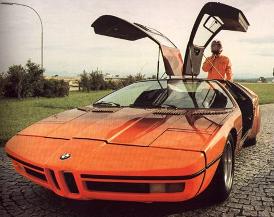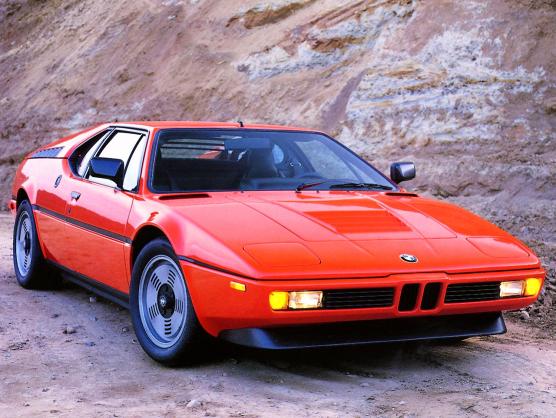|
History of the M1 |
|
The Werk Shop 28814 Nagel Ct., Unit B Lake Bluff, IL 60044 (847) 295.3200 Telephone (847) 615.9375 Fax |
|
Contact: |
|
E-mail: Administrator@ProjectM1.com |
|
Contact: |
|
“Our family stuck together and brought a healthy and wholesome baby into this world: the BMW M1 !”. Words spoken by an excited and proud Jochen Neerpasch in December 1978. The baby was indeed healthy but labor had not been without problems. |

|
Jochen Neerpasch, by all accounts the father of the M1, had been the head of BMW Motorsport GmbH since mid-1972. The history of the M1 actually started before 1972 with the “turbo styling study”. This study resulted in the futuristic looking BMW Turbo. The Turbo was never envisioned as a potential production machine but based on the design some wind-tunnel testing and other engineering work was done. This preliminary work served as a loose guide in the conception of the M1. |
|
The BMW Turbo |
|
BMW had always been active in racing. For a producer of high-performance cars racing is a great way to bring the speed, power and handling of the product to the attention of the customers. There is also a fair amount of cross-pollination between the race and production cars. Production cars are ‘souped up’ to be used as race cars while technologies that prove themselves in racing will ultimately find their way into the production vehicles. |

|
Good looking orphan. |

|
Jochen Neerpasch in 1980 |
|
The early 70s brought success for the aging 3.0 CSL in the Touring Cars competition and BMW Motorsport was producing the dominant engine in Formula 2. Jochen Neerpasch had his eye on a bigger prize. Fiercely competitive, he wanted to crush the other teams in Group 4 and 5 Racing and ultimately develop a BMW team for the Formula 1. The members of the Board of Directors of BMW, a group of men known as the Vorstand, were not being paid to be audacious. They were in the business of producing street cars and had much more to gain -from both a technical and a marketing standpoint- to stay with racing Touring Cars. The seeds for some great corporate intrigue and maneuvering were sown! |
|
Somehow, backed perhaps by the attention the Turbo had generated, Jochen Neerpasch was able to get a green light for the M1 project, originally known as E26, and was given complete responsibility. The goal was to build a car that would rule sports car racing. It might be symptomatic of bad blood between BMW Motorsport and BMW AG that he immediately went to an outside company for the design of his supercar. He took this assignment to a prominent young designer by the name of Giorgetto Giugiaro of a company called Italdesign. To be eligible for group 4 racing the FIA (Fédération Internationale de l'Automobile) required that a minimum of 400 cars were produced and sold to the general public. This is the only reason why the road version of the M1 exists. Building something like the M1 doesn’t fit into the schedule of a company that normally builds cars in a very high volume. The M1 was almost entirely going to be made by hand and Jochen Neerpasch had to find some facilities outside of BMW. A partnership with Lamborghini must have seemed like an obvious and sensible choice. Lamborghini knew how to produce high quality cars, was used to work with small production runs and had excess capacity it needed to fill in order to spread fixed costs over a larger number of units. For a while, especially from an engineering point of view, the cooperation between BMW Motorsport and Lamborghini was very successful. Sadly, when the production was about to start Lamborghini didn’t have the funds to purchase any raw materials in quantity. They were on the brink of bankruptcy. There are some great stories of how a gang of BMW people headed down to Lamborghini to “liberate” the existing prototypes, tools and body-moulds after the decision was made not to throw more money at the Italians. After a delay in the production of more than a year a very complicated and slow method was found to manufacture the M1. This method involved four different companies at four different locations and it meant that cars in varying stages of completeness had to be transported back and forth all over Europe. To add insult to injury the FIA changed their rules during these delays, robbing the M1 of an arena to dominate as it was intended to do. In an effort to salvage the M1 project Jochen Neerpasch scored an incredible coup; the Pro-Car series. The stars of the Formula 1 circuit would race some young, hungry and up-and-coming drivers in identically prepared M1s. These events were organized in support of regular Formula 1 races. The Pro-Car series generated plenty publicity and excitement but in the end it was too little, too late. The M1 had turned into a financial disaster and the Vorstand pulled the plug. The budget for BMW Motorsport was drastically reduced and Jochen Neerpasch left in 1980 to join Talbot. At Talbot he got to set up a Formula 1 team, something the Vorstand wouldn’t allow him to do. The M1, despite being wholesome, was abandoned. An orphan. |

